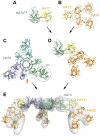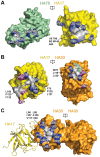Structure of a bimodular botulinum neurotoxin complex provides insights into its oral toxicity
- PMID: 24130488
- PMCID: PMC3795040
- DOI: 10.1371/journal.ppat.1003690
Structure of a bimodular botulinum neurotoxin complex provides insights into its oral toxicity
Abstract
Botulinum neurotoxins (BoNTs) are produced by Clostridium botulinum and cause the fatal disease botulism, a flaccid paralysis of the muscle. BoNTs are released together with several auxiliary proteins as progenitor toxin complexes (PTCs) to become highly potent oral poisons. Here, we report the structure of a ∼760 kDa 14-subunit large PTC of serotype A (L-PTC/A) and reveal insight into its absorption mechanism. Using a combination of X-ray crystallography, electron microscopy, and functional studies, we found that L-PTC/A consists of two structurally and functionally independent sub-complexes. A hetero-dimeric 290 kDa complex protects BoNT, while a hetero-dodecameric 470 kDa complex facilitates its absorption in the harsh environment of the gastrointestinal tract. BoNT absorption is mediated by nine glycan-binding sites on the dodecameric sub-complex that forms multivalent interactions with carbohydrate receptors on intestinal epithelial cells. We identified monosaccharides that blocked oral BoNT intoxication in mice, which suggests a new strategy for the development of preventive countermeasures for BoNTs based on carbohydrate receptor mimicry.
Conflict of interest statement
The authors have declared that no competing interests exist.
Figures






Similar articles
-
The long journey of botulinum neurotoxins into the synapse.Toxicon. 2015 Dec 1;107(Pt A):9-24. doi: 10.1016/j.toxicon.2015.09.009. Epub 2015 Sep 9. Toxicon. 2015. PMID: 26363288
-
Assembly and function of the botulinum neurotoxin progenitor complex.Curr Top Microbiol Immunol. 2013;364:21-44. doi: 10.1007/978-3-642-33570-9_2. Curr Top Microbiol Immunol. 2013. PMID: 23239347 Free PMC article. Review.
-
A novel subunit structure of Clostridium botulinum serotype D toxin complex with three extended arms.J Biol Chem. 2007 Aug 24;282(34):24777-83. doi: 10.1074/jbc.M703446200. Epub 2007 Jun 20. J Biol Chem. 2007. PMID: 17581814
-
Characterization of Hemagglutinin Negative Botulinum Progenitor Toxins.Toxins (Basel). 2017 Jun 15;9(6):193. doi: 10.3390/toxins9060193. Toxins (Basel). 2017. PMID: 28617306 Free PMC article.
-
Uptake of botulinum neurotoxin in the intestine.Curr Top Microbiol Immunol. 2013;364:45-59. doi: 10.1007/978-3-642-33570-9_3. Curr Top Microbiol Immunol. 2013. PMID: 23239348 Review.
Cited by
-
Architecture of the botulinum neurotoxin complex: a molecular machine for protection and delivery.Curr Opin Struct Biol. 2015 Apr;31:89-95. doi: 10.1016/j.sbi.2015.03.013. Epub 2015 Apr 15. Curr Opin Struct Biol. 2015. PMID: 25889616 Free PMC article. Review.
-
Development and evaluation of candidate subunit vaccine and novel antitoxin against botulinum neurotoxin serotype E.Hum Vaccin Immunother. 2020;16(1):100-108. doi: 10.1080/21645515.2019.1633878. Epub 2019 Jul 26. Hum Vaccin Immunother. 2020. PMID: 31210561 Free PMC article.
-
Structural basis of the pH-dependent assembly of a botulinum neurotoxin complex.J Mol Biol. 2014 Nov 11;426(22):3773-3782. doi: 10.1016/j.jmb.2014.09.009. Epub 2014 Sep 18. J Mol Biol. 2014. PMID: 25240768 Free PMC article.
-
High-resolution crystal structure of HA33 of botulinum neurotoxin type B progenitor toxin complex.Biochem Biophys Res Commun. 2014 Apr 4;446(2):568-73. doi: 10.1016/j.bbrc.2014.03.008. Epub 2014 Mar 12. Biochem Biophys Res Commun. 2014. PMID: 24631690 Free PMC article.
-
The Structure and Classification of Botulinum Toxins.Handb Exp Pharmacol. 2021;263:11-33. doi: 10.1007/164_2019_342. Handb Exp Pharmacol. 2021. PMID: 31792680
References
-
- Arnon SS, Schechter R, Inglesby TV, Henderson DA, Bartlett JG, et al. (2001) Botulinum toxin as a biological weapon: medical and public health management. JAMA 285: 1059–1070. - PubMed
-
- Bigalke H (2013) Botulinum toxin: application, safety, and limitations. Curr Top Microbiol Immunol 364: 307–317. - PubMed
-
- Collins MD, East AK (1998) Phylogeny and taxonomy of the food-borne pathogen Clostridium botulinum and its neurotoxins. J Appl Microbiol 84: 5–17. - PubMed
-
- Cheng LW, Onisko B, Johnson EA, Reader JR, Griffey SM, et al. (2008) Effects of purification on the bioavailability of botulinum neurotoxin type A. Toxicology 249: 123–129. - PubMed
Publication types
MeSH terms
Substances
Grants and funding
- 1S10RR23057/RR/NCRR NIH HHS/United States
- P41 GM103403/GM/NIGMS NIH HHS/United States
- 8 P41 GM103403-10/GM/NIGMS NIH HHS/United States
- P41 RR015301/RR/NCRR NIH HHS/United States
- P41RR001209/RR/NCRR NIH HHS/United States
- P41 RR001209/RR/NCRR NIH HHS/United States
- P41GM103393/GM/NIGMS NIH HHS/United States
- 5R01AI091823/AI/NIAID NIH HHS/United States
- R01 AI091823/AI/NIAID NIH HHS/United States
- S10 RR023057/RR/NCRR NIH HHS/United States
- P41 GM103393/GM/NIGMS NIH HHS/United States
- 5P41RR015301-10/RR/NCRR NIH HHS/United States
- U54 AI065359/AI/NIAID NIH HHS/United States
LinkOut - more resources
Full Text Sources
Other Literature Sources
Medical

